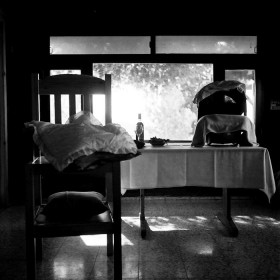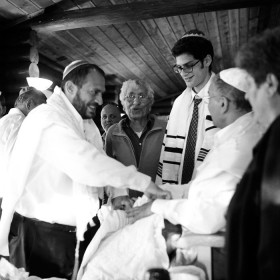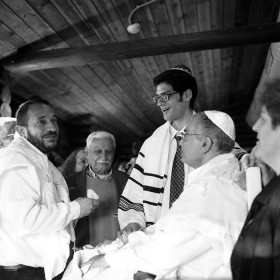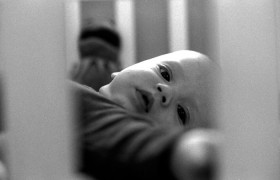
Before the circumcision ceremony: the godfather’s chair and the infant carrier with Yair © photo: Birgit Glatzel
Naomi converted to Judaism six years ago. Shortly afterwards she became pregnant, went to live with her boyfriend Avishay in Tel Aviv, and gave birth there to a son, Yair, who was circumcised as Jewish law demands. In the meantime the couple has moved to Berlin and separated. Naomi recently showed me the photos she took at the ceremony and we talked about her thoughts on ritual circumcision, then and now.
Mirjam: What was your very first thought when you heard you were expecting a son?
Naomi: I was delighted. For Avishay and I, it was also clear from the get-go that we’d have him circumcised. But, to be honest, we neither gave the matter much thought nor prepared for it in any way. It is Jewish tradition to wait until a baby is born before buying stuff or making plans for his circumcision—because not to wait would be tempting fate!
So you’re saying that for you personally, the matter was crystal clear—as in: I am now Jewish and naturally my son will be circumcised?
Yes. In the course I took before converting to Judaism we were given to understand that circumcision plays a pivotal role—it is the sign of the covenant—and we learned also how the ritual is carried out. I must say, however, that hearing about it in the classroom is very different from experiencing a ritual circumcision in real life.

During the circumcision ceremony: Yair lies on his godfather’s lap, father and grandfather are watching him. © photo: Birgit Glatzel
So your son’s Brit Milah was the first ritual circumcision ceremony you ever attended?
Yes. But even for Avishay, who had already attended several such ceremonies, watching his own son be circumcised was something else again. He was standing right next to Yair the whole time and that prompted him to seriously rethink the matter.
Let’s return to the time before Yair’s birth. Were you both certain you wanted a ritual circumcision?
Yes—the proviso being to find a mohel who was also a medical doctor. Yair was born prematurely and we had to wait until he had put on enough weight before going ahead with the circumcision. And that is why I was adamant about finding someone able to assess the potential medical risks.
How long did you have to wait?
About two weeks. By then Yair had reached the minimum requisite weight for circumcision. Avishay’s entire family had been waiting for the news with bated breath—his father called us every single day. The situation stressed me a lot because I felt no one was really interested in my or Yair’s wellbeing, but rather in him gaining enough weight as quickly as possible, so the ceremony could go ahead. The pressure was quite overwhelming.
And where did the ritual circumcision take place—in hospital or at your own home?
We hadn’t married and so Yair’s Brit Milah was seen as a perfect opportunity for a huge family get-together. Avishay and his father went looking for a special place big enough for 80 to 100 people and they found a really nice one in the end. We decided to play Balkan music during the whole gathering so as to avoid being too conventional. And in fact, for most members of Avishay’s family as well as for our friends, the event was first and foremost a fantastic banquet.
And how did you feel while the ritual circumcision was taking place?
I literally hid behind my camera. That was the strategy I’d devised in advance: to watch it all through a lens, because that was the only way I’d be able somehow to be present yet simultaneously at a distance. Mothers frequently choose not to attend the ceremony at all—so lots of women were astonished by my determination to do so. But I actually went through the whole thing in a fog and it only hit me afterwards how intense it had been. The reality of circumcision is another thing altogether than all one hears about beforehand, or sees in films. And I probably just hadn’t wanted to think about it too much anyhow. To do so would have brought up all kinds of misgivings.
What have you done with the photographs? Have you made an album or put them away somewhere?
I took the photos with a Rolleiflex and then made scans of them. So they are now in a folder on my computer—there’s no actual album as such.
Does the fact that you didn’t produce an album mean you cannot yet lay the matter to rest?
Yes, it was only later that I had some doubts—as to whether Yair is now traumatized for instance. And I also started to wonder: Just what exactly went down here? Circumcision had always seemed vital to me, simply as a means to ensure that Yair would be no different than other boys in Israel—despite having a German mother.
So, if you ever have another son, will you have him circumcised?
I really can’t say, because I’m not yet in that situation. I probably would—but in hospital.
Naomi was in conversation with Mirjam Wenzel, Media
Further information about the exhibition “Snip it! Stances on Ritual Circumcision” on www.jmberlin.de/snipit.

